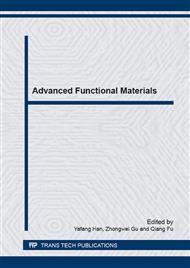[1]
H. Toutanji, B. Xu, J. Gilbert, T. Lavin, Properties of poly(vinyl alcohol) fiber reinforced high-performance organic aggregate cementitious material: Converting brittle to plastic, Constr. Build. Mater. 24(2010) 1-10.
DOI: 10.1016/j.conbuildmat.2009.08.023
Google Scholar
[2]
W.S. Lyoo, W.S. Ha, Preparation of syndiotacticity-rich high molecular weight poly(vinyl alcohol) microfibrillar fiber by photoinitiated bulk polymerization and saponification, J. Polym. Sci. Pol. Chem. 35(1997) 55–67.
DOI: 10.1002/(sici)1099-0518(19970115)35:1<55::aid-pola7>3.0.co;2-1
Google Scholar
[3]
E. Chiellini, A. Corti, R. Solaro, Biodegradation of poly(vinyl alcohol) based blown films under different environmental conditions, Polym. Degrad. Stabil. 64(1999) 305-312.
DOI: 10.1016/s0141-3910(98)00206-7
Google Scholar
[4]
S. Matsumura, N. Tomizawa, A. Toki, K. Nishikawa, K. Toshima, Novel poly(vinyl alcohol)-degrading enzyme and the degradation mechanism, Macromolecules. 32(1999) 7753-7761.
DOI: 10.1021/ma990727b
Google Scholar
[5]
H. Fujiwara, M. Shibayama, J.H. Chen, S. Nomura, Preparation of high-strength polyvinyl-alcohol) fibers by crosslinking wet spinning, J. Appl. Polym. Sci. 37(1989) 1403-1414.
DOI: 10.1002/app.1989.070370522
Google Scholar
[6]
P.J. Barham, A. Keller, High-strength polyethylene fibers from solution and gel spinning, J. Mater. Sci. 20(1985) 2281-2302.
DOI: 10.1007/bf00556059
Google Scholar
[7]
S.H. Hu, Y. T Zhang, Current R & D situation of PVA fibers vinylon and kuralon K-Ⅱ, Textile Technology Overseas, 10(2001) 10-13.
Google Scholar
[8]
Y.G. Jo, E.J. Shin, Y.J. Lee, W.S. Yoon, S.S. Han, Y.H. Lee, Y.R. Lee, S.K. Noh, Y.S. Gal, W.S. Lyoo, Effect of gel spinning accompanied with cross-linking using boric acid on the structure an properties of high-molecular-weight poly(vinyl alcohol) fiber, J. Appl. Polym. Sci. 113(2009).
DOI: 10.1002/app.30084
Google Scholar
[9]
Y.I. Mitchenko, A.N. D'yachkov, L.D. Rudneva, Production of high-strength fibers of high-molecular-weight polyvinyl alcohol by gel technology, Fiber Chem. 43(2011) 41-46.
DOI: 10.1007/s10692-011-9306-3
Google Scholar
[10]
M.X. Li, K. Wang, Development of high strength-high modulus PVA fibers, Synthetic Fiber in China (in Chinese), 1(2003) 21-23.
Google Scholar
[11]
J. Kaursoin, A.K. Agrawal, Melt spun thermoresponsive shape memory fibers based on polyurethanes: Effect of drawing and heat-setting on fiber morphology and properties, J. Appl. Polym. Sci. 103(2007) 2172–2182.
DOI: 10.1002/app.25124
Google Scholar
[12]
V.B. Gupta, Heat setting, J. Appl. Polym. Sci. 83(2002) 586–609.
Google Scholar


